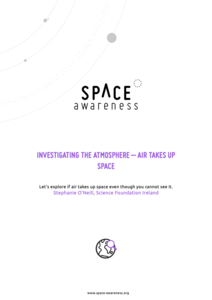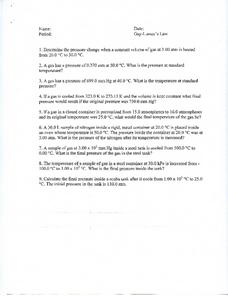Concord Consortium
Hydrogen Bonds: A Special Type of Attraction
How does hydrogen bonding explain ice crystals? An engaging interactive answers just that. Scholars explore how polar molecules interact and observe the changes as temperature fluctuates as well as the hydrogen bond attraction.
Concord Consortium
Molecular View of a Gas
Welcome to the fast-paced life of a gas atom! Learners gaze at gaseous atoms up close using a colorful interactive. They can highlight two atoms and observe their movements within their container or follow the dizzying path of one atom...
Space Awareness
Investigating the Atmosphere - Air Takes Up Space
How do you know there is air? Can you see it, smell it, feel it? To begin the investigation, learners watch a video and discuss what they know about air and the atmosphere. Then, they participate in five different hands-on, inquiry-based...
Space Awareness
Continental Climate and Oceanic Climate
There's nothing better than a cool breeze blowing in from the ocean. Scholars explore how water affects change in temperature using a hands-on experiment on climate. They use measurement tools to compare the continental and oceanic...
American Chemical Society
The Water Cycle
Bring the water cycle into the classroom without the mess. Learners build a model of the water cycle using everyday materials. They observe the process of evaporation and condensation and relate their observations to the larger scale...
Curated OER
Winter Survival
Students examine what animals need in order to survive. In this investigative lesson students play a "role" of an animal in winter.
Curated OER
Kitchen Chemistry
Fifth graders examine both physical and chemical changes, and how to identify the difference between the two. They observe the changes that occur in butter when it is exposed to heat and cold, heat energy. In their notebooks, they write...
Curated OER
Energy in Today's Global Society
Students explain how heat is used to generate and produce electricity. In this energy lesson plan students complete several activities that show them about the different fuels used for heating.
Curated OER
Green Roof Design
High schoolers design a heat and water conserving "green roof". In this urban environmental lesson, students will design a heat and water conserving "green roof" to improve a building's energy profile.
Curated OER
Miniature Water Cycles
Students construct a model of the water cycle in action using two-liter pop bottles to build a terrarium. Locate examples of evaporation and condensation in the water cycle (e.g., water evaporates when heated and clouds or dew forms when...
Curated OER
Blood Pressure and Heart Disease
Students explore the major causes of heat attacks as the topics of the human circulatory system, blood pressure, heart disease, arteries and veins are examined. Opinions on the topics are developed as researched material is presented to...
Curated OER
Scale Factors for Areas and Volumes
Students examine mathematical questions. They examine how to tackle mathematical questions and discover the effect of a change in length on area and volume. They examine the consequences of the physical properties sea animals on heat...
Curated OER
Changes In Matter, "The Big Chill"
Third graders investigate why ice cream does not go through any chemical changes when it is exposed to physical changes. They describe the three states of matter in either written or verbal form. Then students experiment with ice cream...
Curated OER
Some Like It Hot, Some Like It Cold
Students are explained that thermophiles are organisms that have optimal growth temperatures above 50oC. They investigate the temperature ranges for the growth of common bacteria. Students answer the question of do either of these...
Curated OER
Convection in a Pan
Students watch a demonstration using a plastic bag and a hair dryer to create a hot air balloon. After the demonstration, they discuss the results and whether or not hot water behaves the in the same manner as hot air. They conduct...
Curated OER
Gay-Lussac's Law
In this Gay-Lussac's Law worksheet, students determine the pressure change when a constant volume of gas is heated. Then they identify what the pressure is at standard temperature. Students also determine and calculate the final pressure...
Curated OER
Enthalpy
In this enthalpy worksheet, students use the bond energy to calculate the change in heat for the reaction. This worksheet has 2 problems to solve.
Curated OER
Changing State
Students investigate the cooling and heating of water. In this online science experiment lesson, students work in groups to make predictions regarding freezing and boiling points and then test those predictions as they complete the...
Curated OER
Angle of Sunlight Lab
In this sunlight instructional activity, students use a flashlight to simulate the angles sun shines. They shine the light on a graph at various angles and trace the lighted areas. They answer questions about the differences in the...
Curated OER
Build a Pizza Box Solar Oven
Students build a solar oven. In this solar energy lesson plan, students follow directions that show them how to build a solar oven made from a pizza box that can heat up food.
Curated OER
Seasons on Earth
Students examine how seasons occur and explore how the different angles effect surface heating. In this climate lesson students interpret satellite maps of the world that show seasonal differences in plant life.
Curated OER
Solid Water
Students turn solid water (ice) into liquid water. In this solid and liquid water lesson plan, students use water, ice, cups, and heat in order to change water from one state to another. They draw their findings as well.
Curated OER
Rain Formation
First graders investigate the different water formations by conducting an experiment. In this water properties lesson, 1st graders examine jars filled with ice, rain water, air and snow in their class. Students predict what will happen...
Curated OER
Soil Isn't a Dirty Word
Students investigate the properties of rocks. In this geology lesson plan, students draw their profile and discuss what a soil profile would look like. Additionally, students demonstrate how to make soil by rubbing two pieces of...
Other popular searches
- Heat Transfer
- Heat Energy
- Specific Heat
- Heat Capacity
- Heat and Temperature
- Color and Heat Absorption
- Heat Absorption
- Conduction Heat Transfer
- Heat Conduction
- Conducting Heat
- Heat and Evaporation
- Heating and Cooling

























